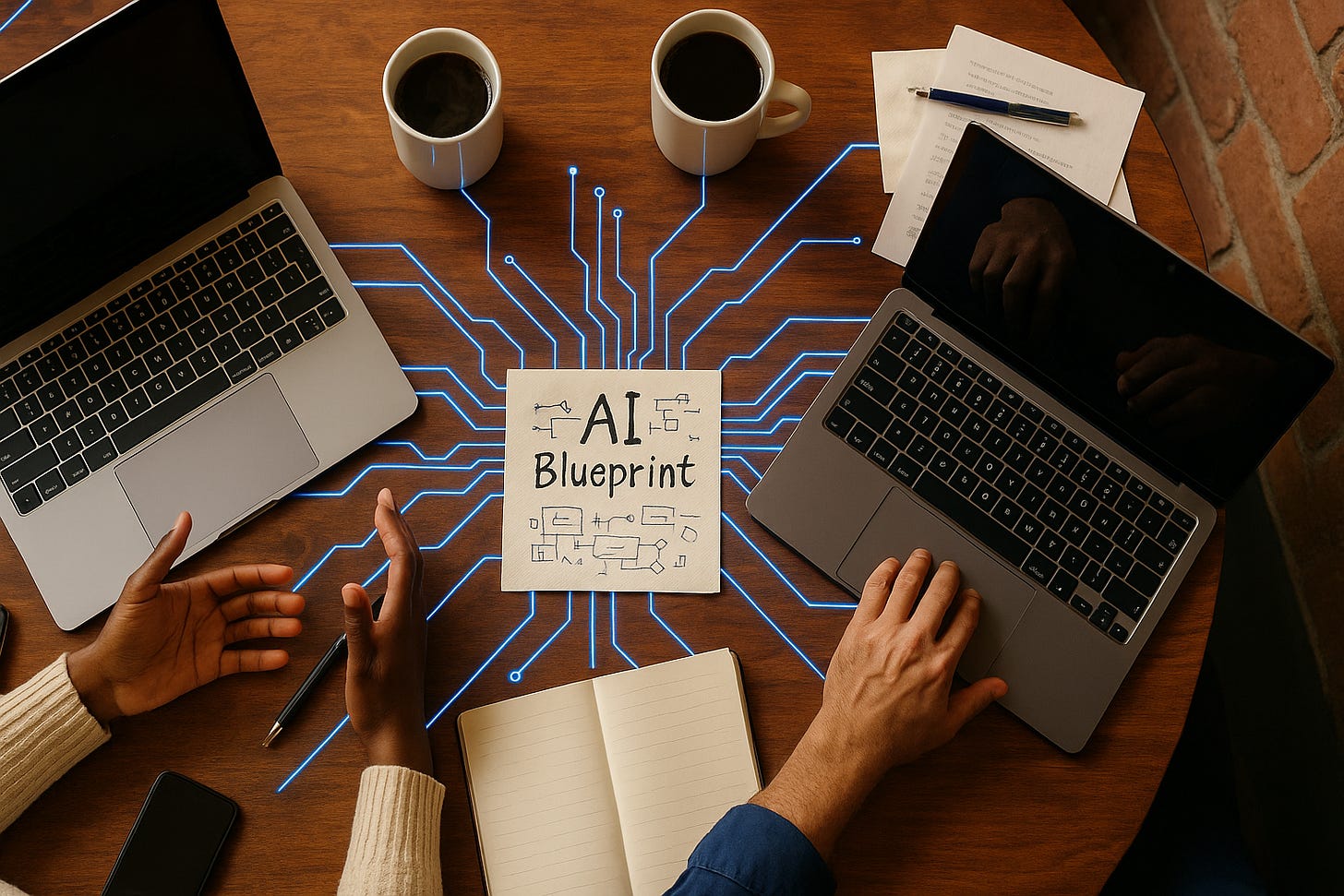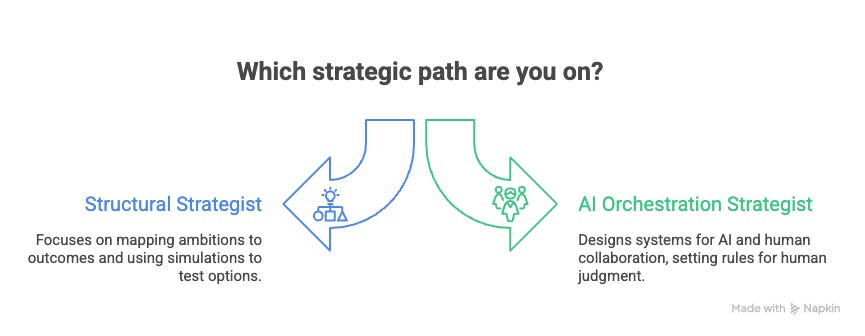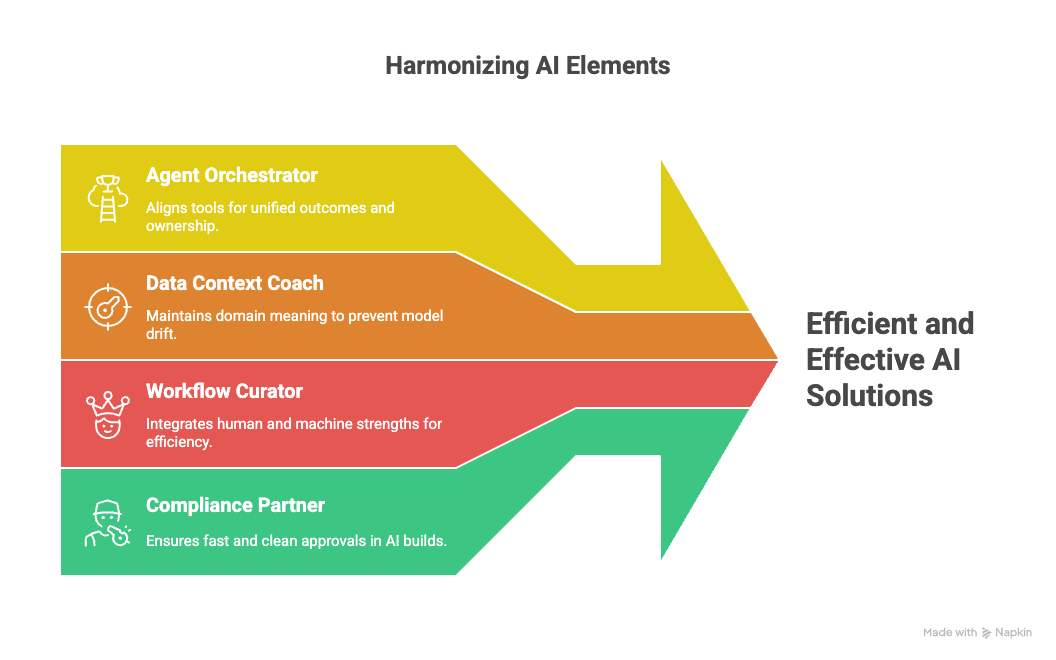Stop Managing AI Tools and Start Leading Beyond Automation
How to Design Human-AI Collaboration That Actually Multiplies Your Impact (Guest)
Thanks for reading! To access our community, full prompt library, coaching, and AI tools saving leaders 5-10 hours per week, check out our Premium Hub.
Have you ever watched a construction crew try to build a house without blueprints?
That's exactly what I see happening in teams and companies across the world. Leaders are throwing AI tools at their teams like they're handing out hammers, expecting a cathedral to emerge from the chaos.
The problem isn't AI, but that most leaders are trying to bolt artificial intelligence onto workflows designed for humans working alone.
The result? Friction, shadow processes, and fuzzy accountability.
What if there was a better way? What if you could design human-AI collaboration as intentionally as you design your strategy or your org chart?
Fellow Substack creator Gary The AI Strategist, and author of "Gary the AI Strategist," has been studying this exact challenge. Gary helps leaders use AI for true strategic intelligence and has created positive change with Nickelodeon, EY, Unilever, P&G, Nestlé, UNICEF, and more. As the founder of GoodMora and a strategist who's worked in the C-suite, he's identified why some leaders are already winning with AI while others are drowning in expensive chaos.
Here's what Gary has discovered about leading beyond automation…
Leading Beyond Automation
How human and AI collaboration becomes a leadership discipline
Because GoodMora is built to unlock and augment human creativity in strategy, I am drawn to the work-futurists who study how roles evolve. We keep circling the same truth. The real unlock now is how leaders redesign work so humans and AI can do their best work together. The live question is how traditional roles change when you take that seriously. This is not a chicken-and-egg puzzle. Formal human-AI collaboration reveals the needs that shape the jobs of the future. In our world, that includes the strategist.
Two practical paths for the strategist are already taking shape:
Structural strategist. Owns the map between ambition and outcomes, uses simulation to test options before a launch, and steers trade-offs across revenue, risk, and change capacity.
AI orchestration strategist. Designs the system in which agents, models, and people work together, sets rules for when judgment stays human, and measures lift in the flow of work.
This evolution has dependencies. You need clean access to operational data, governance that names a single owner for outcomes, incentives that reward team-level wins over tool usage, learning sprints inside real workflows, and time created by stopping low-value work. Without those, collaboration stays theoretical. With them, it becomes a compounding advantage.
Why Joel and I are teaming up
This is the conversation Joel Salinas is advancing on Leadership in Change. He brings a rigorous lens to leadership, ethics, and accountability. I bring the structure side through GoodMora's simulation stack. Together, we want to move the dialogue from principles to practice. What follows opens the series: a field guide to leading beyond automation.
The narrative gap
Most AI talk stays fixed on job loss, cost take out, and tool rollouts. The data already tells a more complex story. Employers expect about 44 percent of core skills to change by 2027, which points to redesign rather than simple replacement. At the same time, only about four in ten adults engage in formal learning each year across OECD countries, with wide variation by nation. The signal is clear. Skills move faster than learning, so leaders face a design problem, not only a technology problem.
Sources: World Economic Forum, Future of Jobs 2023. OECD, Trends in Adult Learning 2025.
AI is reshaping roles, not only removing them.
In highly regulated sectors, you can already see the pattern. UK financial services report broad AI use across IT operations, customer support, fraud, and compliance. Regulators are watching closely. Capability is rising, readiness lags.
Many firms plan to increase their spending on generative AI, while only a minority feels prepared for regulation or has a structured training program in place.
Bank of England, Artificial Intelligence in UK Financial Services 2024. EY, European Financial Services AI Survey 2024.
Well-designed programs tend to complement people rather than replace them, and they lift job satisfaction when the work is intentionally redesigned. Research at MIT and others continues to show that human and AI complementarity outperforms substitution in many knowledge settings. In labor markets, AI skills earn a wage premium across industries, suggesting value creation in augmented roles, rather than displacement.
Sources: MIT Sloan, Human AI Collaboration in the Workplace 2023. PwC, AI Jobs Index 2025.
The leadership blind spot is structure.
Reskilling is necessary, but it is not sufficient.
Most failures we see come from trying to bolt AI onto workflows built for slower, human-only sequences. The result is friction, shadow processes, and fuzzy accountability.
Three structural questions sort the noise quickly:
Who owns outcomes when a machine makes the first move?
How do we keep meaningful human control where reversibility is low and the blast radius is high?
Which parts of judgment are not delegable in this domain, and how are they protected?
Regulators are nudging in the same direction. The Financial Conduct Authority in the United Kingdom emphasizes principles, accountability, and proportionality. That puts design choices back on leadership rather than on a static rules checklist.
Source: FCA, AI Update 2024.
Design collaboration like a system
When collaboration is the goal, new roles and routines emerge. In practice, four patterns pay off:
Agent orchestrator aligns multiple tools to a single outcome and owner
Data context coach keeps domain meaning intact so models do not drift
Workflow curator places humans and machines where each creates edge
Compliance partner sits in the build so approvals are fast and clean
Done well, this raises performance and reduces burnout by improving work design, not just workload.
Source: MIT Sloan, Human AI Collaboration in the Workplace 2023.
A simple frame you can use tomorrow
When we work with leaders, we start with two moves:
Classify decisions before rollout.
Human only. Human with machine advice. Machine-led with human oversight. Then test each class for reversibility, blast radius, and contestability. If any test fails, keep a human firmly in the loop and make that loop visible.
Simulate before you commit.
Run a small simulation of the workflow and incentives. Look for where accountability breaks, who owns the exception path, and which metrics must be visible to everyone.
For busy leaders, this may seem like too much work. But that is old thinking. Here is an example of human-AI collaboration at the highest level. Our Business Genome maps how a strategy actually connects to outcomes, benchmarks it against relevant analogues, and lets you simulate options with attention to revenue, risk, and change capacity. Leaders see the ripple effects before they spend political or financial capital. It turns debate into design.
What collaboration unlocks
When you design for humans and AI to work together, three benefits show up early:
Attention shifts to higher-order work. Teams spend less time on repetitive pattern tasks and more time on structural choices, creative leaps, and partner design.
Discovery of adjacent value. Faster cycles and lower error rates open new service layers, pricing models, or customer journeys that were not feasible before.
Healthier organizations. Clear accountability, visible metrics, and a shared map reduce fear and improve engagement. People know where judgment sits and why.
Where the series goes from here
Joel and I will build from this starting point. Next, we will publish a compact governance kit you can adapt in a week. After that, we will share a short, anonymized simulation, so you can see the method and the outcomes before trying it in your context. We will also invite leaders to share real-world examples so we can learn from them in public and improve the model together.
Closing
In the C-suite, I learned how to maintain perspective when the stakes are high. As a founder, I learned how to keep clarity when the guardrails fall away. That is what I bring into this work now. AI multiplies capability. Only the structure and the clarity of the design for it make that capability compound. The leaders who thrive will be the ones who can hold both.
See GoodMora’s Business Genome in action. Please download our whitepaper or contact me here for a demo.
If you want to go deeper, follow this series with Joel on Leadership in Change and me.
Thanks, Gary!
Making This Work in Your Context - Master Prompt
Gary's framework gives us the structure, but how do you actually implement this starting Monday morning?
You can access the Leading Beyond AI master prompt for workflow help and optimization in our Premium Hub, along with all of our other tools.
If You Only Remember This
The real challenge is structural, not technical
Use Gary's two-move framework: classify decisions, then simulate workflows
Four new roles emerge: orchestrator, coach, curator, and compliance partner
Stop bolting AI onto human workflows and start designing collaboration systems
Leaders who thrive will hold both capability and clarity
How are you currently approaching the control vs. delegation challenge with AI in your organization?
Let’s Connect
I love connecting with people. Please use the following to connect, collaborate, if you have an idea, or just want to engage further:
LinkedIn / Community Chat / Email / Medium









This is the crucial shift - from just implementing AI tools to intentionally designing human-AI collaboration systems. That structural approach is what turns automation into true operational leverage. It’s exactly the kind of strategic execution I explore in The Efficiency Playbook.
This is spot on! AI isn’t just a tool to bolt on. Designing workflows where humans and AI collaborate intentionally multiplies impact. The two-move framework (classify, simulate) is simple but powerful for real-world implementation.
For more AI trends and practical insights, check out my Substack, where I break down the latest in AI.